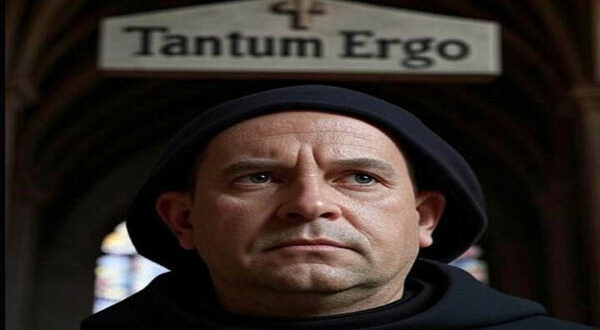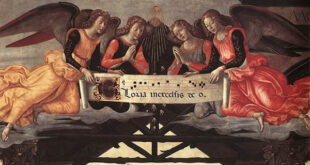Introduction: A hymn that still speaks to the soul
In a world that rushes forward without pause and easily forgets the sacred, a soft yet powerful melody continues to echo in chapels, churches, and the hearts of the faithful: the “Tantum Ergo.” Two Latin words that encapsulate centuries of faith, mystery, and adoration. This hymn, composed by one of the giants of Catholic theology, St. Thomas Aquinas, is not merely a relic of bygone times but a spiritual key that opens the heart to the Real Presence of Christ in the Eucharist.
This article is an invitation to pause, listen, and contemplate. To rediscover the “Tantum Ergo” not as a musical piece reserved for Benediction, but as a profound theological prayer capable of transforming your way of living the faith amid the noise of the 21st century.
1. The origin of the “Tantum Ergo”: St. Thomas and Corpus Christi
The “Tantum Ergo” is actually the final part of the longer hymn “Pange Lingua Gloriosi Corporis Mysterium,” composed in the 13th century by St. Thomas Aquinas at the request of Pope Urban IV, who had instituted the Solemnity of Corpus Christi for the universal Church.
The commission was no small matter: to celebrate the Eucharistic mystery, the truth that Christ is truly present—Body, Blood, Soul, and Divinity—in the Blessed Sacrament of the altar. St. Thomas, the Angelic Doctor, did not turn to abstract speculation, but rather wrapped the highest theology in poetic, mystical, and profoundly devotional language.
The “Tantum Ergo” is traditionally sung during Eucharistic Adoration, just before Benediction with the Blessed Sacrament. It is a way of paying homage and surrendering to the One who is veiled under the appearances of bread.
2. Full Text of the Tantum Ergo (Latin and English)
TANTUM ERGO SACRAMENTUM
VENEREMUR CERNUI
ET ANTIQUUM DOCUMENTUM
NOVO CEDAT RITUI
PRAESTET FIDES SUPPLEMENTUM
SENSUUM DEFECTUI.
GENITORI GENITOQUE
LAUS ET IUBILATIO
SALUS, HONOR, VIRTUS QUOQUE
SIT ET BENEDICTIO
PROCEDENTI AB UTROQUE
COMPAR SIT LAUDATIO.
Amen.
ENGLISH TRANSLATION:
DOWN IN ADORATION FALLING,
LO! THE SACRED HOST WE HAIL,
LO! O’ER ANCIENT FORMS DEPARTING,
NEWER RITES OF GRACE PREVAIL;
FAITH FOR ALL DEFECTS SUPPLYING,
WHERE THE FEEBLE SENSES FAIL.
TO THE EVERLASTING FATHER,
AND THE SON WHO REIGNS ON HIGH,
WITH THE HOLY GHOST PROCEEDING
FORTH FROM EACH ETERNALLY,
BE SALVATION, HONOR, BLESSING,
MIGHT AND ENDLESS MAJESTY.
Amen.
3. A Theological Gem: What does the Tantum Ergo say to us?
a. “Tantum ergo Sacramentum veneremur cernui”: Let us fall in adoration
St. Thomas begins with a clear invitation: let us bow in reverence before this great Sacrament. Here, the physical act of adoration (kneeling, bowing) becomes a reflection of an interior disposition: humility, reverence, awe.
“All who go down to the dust will kneel before Him” (Psalm 22:29)
In a culture that idolizes autonomy and rejects submission, the Tantum Ergo reminds us that true freedom begins when we acknowledge Christ as Lord, especially in the Eucharist.
b. “Et antiquum documentum novo cedat ritui”
The Old Covenant with its foreshadowings (such as the manna in the desert) gives way to the New Covenant, fully realized in Christ and perpetuated in the Eucharist. We no longer live by symbols alone, but by the living presence of Jesus.
St. Thomas emphasizes the continuity and fulfillment between the Old and New Testaments. On the altar, heaven touches earth and the past is fulfilled in God’s eternal present.
c. “Praestet fides supplementum sensuum defectui”
This phrase is a perfect summary of the Catholic Eucharistic realism: when the senses fail (we do not see, touch, or perceive clearly), faith supplies what is lacking. We do not see Jesus with our bodily eyes, but we do with the eyes of faith.
“Blessed are those who have not seen and yet have believed” (John 20:29)
The “Tantum Ergo” forms us in a spirituality of deep faith, against the modern temptation to “see in order to believe.” Here we are invited to “believe in order to see” beyond appearances.
d. Final doxology: Trinitarian praise
The second stanza gives glory to the Father (Genitori), the Son (Genitoque), and the Holy Spirit (Procedenti ab utroque). We are not adoring a thing, a symbol, or an idea, but the Triune God Himself present in the Sacrament.
The end of the hymn is pure praise: glory, jubilation, honor, salvation, power, and blessing. Everything we are becomes praise when we are before the Blessed Sacrament.
4. Practical Applications: How to live the “Tantum Ergo” today
a. Recovering the sense of adoration
In many parishes, Eucharistic adoration has been reduced or lost its solemnity. The “Tantum Ergo” is a reminder that adoration is not optional, but vital. Rediscovering personal and communal Eucharistic adoration transforms lives.
Ask yourself: When was the last time you were in silence before the Blessed Sacrament?
b. Educating ourselves in silence and mystery
We live surrounded by stimuli, but the Eucharist teaches us in reverent silence and contemplation. Praying the “Tantum Ergo” slowly, meditating on it, letting its words penetrate the soul, is a spiritual exercise for every believer.
c. Strengthening Eucharistic faith
In times of doctrinal and liturgical confusion, when even the Real Presence is questioned, the Tantum Ergo is an antidote: a clear and resounding affirmation that Christ is truly present.
Teach this hymn to your children. Sing it with your family. Let it become part of your spiritual routine.
d. Renewing liturgy and catechesis
The Tantum Ergo should and can be part of liturgical and catechetical formation. It is accessible, beautiful, and deep. For both children and adults, its teaching can open the heart to the Eucharistic mystery in a way abstract discourse cannot.
5. Conclusion: “Let us fall in adoration”
The “Tantum Ergo” is not merely a song from the past. It is a profession of faith, an act of love, a school of adoration. In times of spiritual superficiality, this hymn brings us back to the center: Christ present in the Eucharist.
To rediscover it, meditate on it, and live it may be a small act of resistance against modern indifference. It is the silent cry of faithful adorers who, like St. Thomas, know that there, in the consecrated Host, dwells all of heaven.
“Lord, I believe; help my unbelief.” (Mark 9:24)
May every time you pray the “Tantum Ergo,” your soul bow in humility, and your heart fill with wonder, knowing that you are before the very God who created the universe and became Bread for you.






